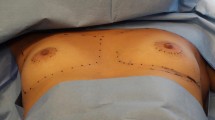Abstract
Background
Subfascial breast augmentation, first performed by Dr. Ruth Graf in 1998, places the implant above the pectoralis muscle but below the pectoralis fascia. Graf documented that this approach resulted in less capsular contracture than subglandular implant placement and a more natural shape while eliminating implant animation with arm movement. In addition, implant edge visibility was decreased compared with subglandular implantation in all but the extremely thin patient. Because of the described benefits and high patient satisfaction, the authors began to perform this technique in 2006.
Methods
This report presents a comprehensive review of the aforementioned technique by describing a large series of subfascial augmentations (inframammary, periareolar, and endoscopic transaxillary) as primary procedures, secondary procedures, and operations with concurrent use of mastopexy performed by a single surgeon using multiple approaches. A patient satisfaction questionnaire was used in addition to a detailed clinical assessment.
Results
The results of this procedure were reproducible, controllable, and predictable. The study demonstrated a high degree of patient and surgeon satisfaction with few complications, a low rate of capsular contracture, no evidence of breast animation with arm movement, excellent lower pole coverage, and a brief recovery period.
Conclusions
Subfascial breast augmentation is a safe, effective procedure allowing for predictable results with excellent shape and longevity. For the properly selected patient, this approach provides the benefits of subglandular and submuscular placement without the disadvantages associated with each.












Similar content being viewed by others
References
Cronin TD, Gerow FJ (1964) Augmentation mammaplasty: a new “natural feel” prosthesis. In: Transactions of the third international congress of plastic surgery. Excerpta Medica Foundation, Amsterdam, pp 41–49
Dempsey WC, Latham WD (1968) Subpectoral implants in augmentation mammaplasty: preliminary report. Plast Reconstr Surg 42:515–521
Goes JCS, Landecker A (2003) Optimizing outcomes in breast augmentation: seven years of experience with the subfascial plane. Aesth Plast Surg 27:178–184
Graf RM, Bernardes A, Auersvald A, Costa Damasio RC (2000) Subfascial endoscopic transaxillary augmentation mammaplasty. Aesth Plast Surg 24:216–220
Graf RM et al (2003) Subfascial implant: a new procedure. Plast Reconstr Surg 111:904–908
Jinde L et al (2006) Anatomy and clinical significance of pectoral fascia. Plast Reconstr Surg 118:1160–1557
Mladick RA (1993) “No-touch” submuscular saline breast augmentation technique. Aesth Plast Surg 17:183–192
Munhoz AM et al (2006) Subfascial transaxillary breast augmentation without endoscopic assistance: technical aspects and outcome. Aesth Plast Surg 30:503–512
Puckett CL, Croll GH, Reichel CA, Concannon MJ (1987) A critical look at capsule contracture in subglandular versus subpectoral mammary augmentation. Aesth Plast Surg 11:23–28
Ramirez OM, Heller L, Tebbetts JB (2002) Dual-plane breast augmentation: avoiding pectoralis major displacement. Plast Reconstr Surg 110:1198
Serra-Renom JM, Garrido MF, Yoon T (2005) Augmentation mammaplasty with anatomic soft, cohesive silicone implant using the transaxillary approach at a subfascial level with endoscopic assistance. Plast Reconstr Surg 116:640–645
Siclovan HR, Jomah JA (2008) Advantages and outcomes in subfascial breast augmentation: a two-year review of experience. Aesth Plast Surg 32:426–431
Spear SL, Schwartz J, Dayan JH, Clemens MW (2009) Outcome assessment of breast distortion following submuscular breast augmentation. Aesth Plast Surg 33:44–48
Stoff-Khalili MA, Scholze R, Morgan WR, Metcalf JD (2004) Subfascial periareolar augmentation mammaplasty. Plast Reconstr Surg 114:1280–1291
Tebbetts JB (2006) Dual-plane breast augmentation: optimizing implant–soft tissue relationships in a wide range of breast types. Plast Reconstr Surg 118(7 Suppl):81S–98S
Vazquez B, Given KS, Houston GC (1987) Breast augmentation: a review of subglandular and submuscular implantation. Aesth Plast Surg 11:101–105
Acknowledgment
We thank Dr. Margie Aitken for providing an artistic depiction of the fascial system of the breast.
Author information
Authors and Affiliations
Corresponding author
Rights and permissions
About this article
Cite this article
Hunstad, J.P., Webb, L.S. Subfascial Breast Augmentation: A Comprehensive Experience. Aesth Plast Surg 34, 365–373 (2010). https://doi.org/10.1007/s00266-009-9466-1
Received:
Accepted:
Published:
Issue Date:
DOI: https://doi.org/10.1007/s00266-009-9466-1




